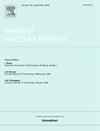用气体标签验证乏核燃料安全壳完整性的方法
IF 2.3
3区 工程技术
Q1 NUCLEAR SCIENCE & TECHNOLOGY
引用次数: 0
摘要
商业核工业和美国能源部(DOE)管理的乏核燃料(SNF)管理系统需要对容器完整性进行验证,特别是在延长储存之后。一些SNF存储系统在一个较大的容器中容纳几个较小的容器。这些无法进入的容器的泄漏识别是具有挑战性的,因为它们的内容通常相似。如果怀疑容器受损,这可能导致昂贵的重新包装操作。本文提出了一种氙气标记方法,用于唯一地识别SNF容器。考虑了两种不同的doe管理的SNF加载配置的公路干存储系统。所需的标记剂体积主要由较低的检测限和受损容器中标记剂的泄漏率驱动,而不是SNF中裂变产生的氙的数量。虽然所提出的方法适用于较大的泄漏,但这种气体标记方法可以应用于较小的泄漏和其他SNF管理系统。本文章由计算机程序翻译,如有差异,请以英文原文为准。
An approach for spent nuclear fuel containment integrity verification using gas tagging
Verification of containment integrity is required for spent nuclear fuel (SNF) management systems managed by the commercial nuclear industry and U.S. Department of Energy (DOE), especially after extended storage. Some SNF storage systems hold several smaller containments within a larger container. Leakage identification of these inaccessible containments is challenging because their contents are often similar. This could result in costly repackaging operations if compromised containments are suspected. This paper presents a xenon gas tagging approach for uniquely identifying SNF containments. A road-ready dry storage system is considered with two different DOE-managed SNF loading configurations. The required taggant volume is driven primarily by the lower detection limit and leak rate of taggant from a compromised containment, rather than the amount of fission-generated xenon within the SNF. While the approach presented is suited for larger leaks, this gas tagging approach can be applied to smaller leaks and other SNF management systems.
求助全文
通过发布文献求助,成功后即可免费获取论文全文。
去求助
来源期刊

Annals of Nuclear Energy
工程技术-核科学技术
CiteScore
4.30
自引率
21.10%
发文量
632
审稿时长
7.3 months
期刊介绍:
Annals of Nuclear Energy provides an international medium for the communication of original research, ideas and developments in all areas of the field of nuclear energy science and technology. Its scope embraces nuclear fuel reserves, fuel cycles and cost, materials, processing, system and component technology (fission only), design and optimization, direct conversion of nuclear energy sources, environmental control, reactor physics, heat transfer and fluid dynamics, structural analysis, fuel management, future developments, nuclear fuel and safety, nuclear aerosol, neutron physics, computer technology (both software and hardware), risk assessment, radioactive waste disposal and reactor thermal hydraulics. Papers submitted to Annals need to demonstrate a clear link to nuclear power generation/nuclear engineering. Papers which deal with pure nuclear physics, pure health physics, imaging, or attenuation and shielding properties of concretes and various geological materials are not within the scope of the journal. Also, papers that deal with policy or economics are not within the scope of the journal.
 求助内容:
求助内容: 应助结果提醒方式:
应助结果提醒方式:


